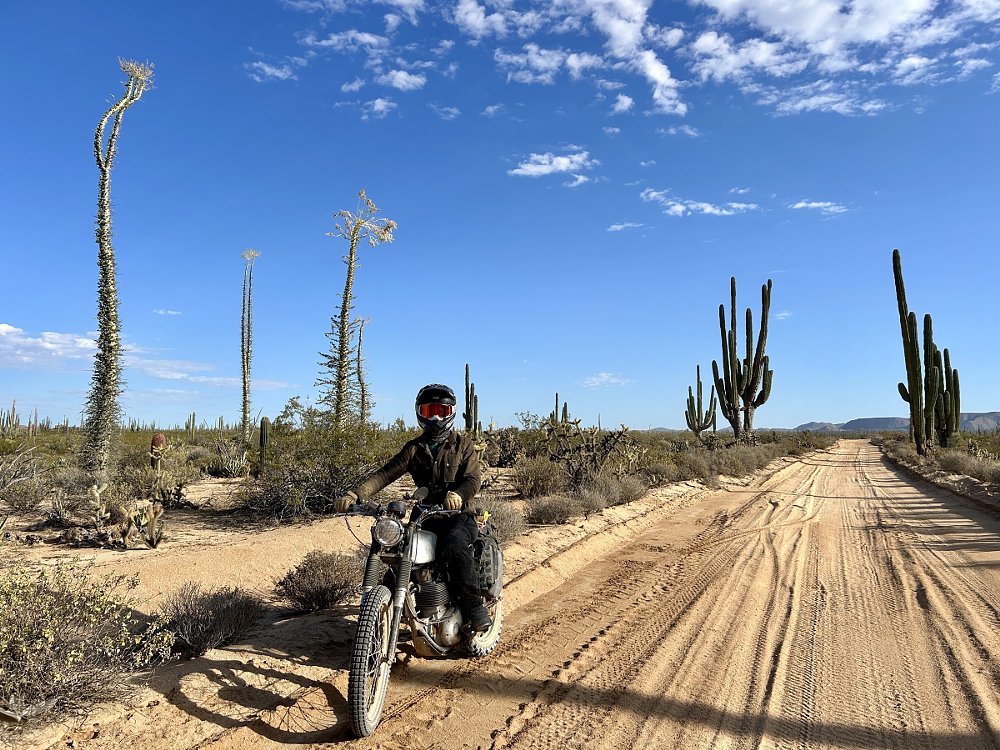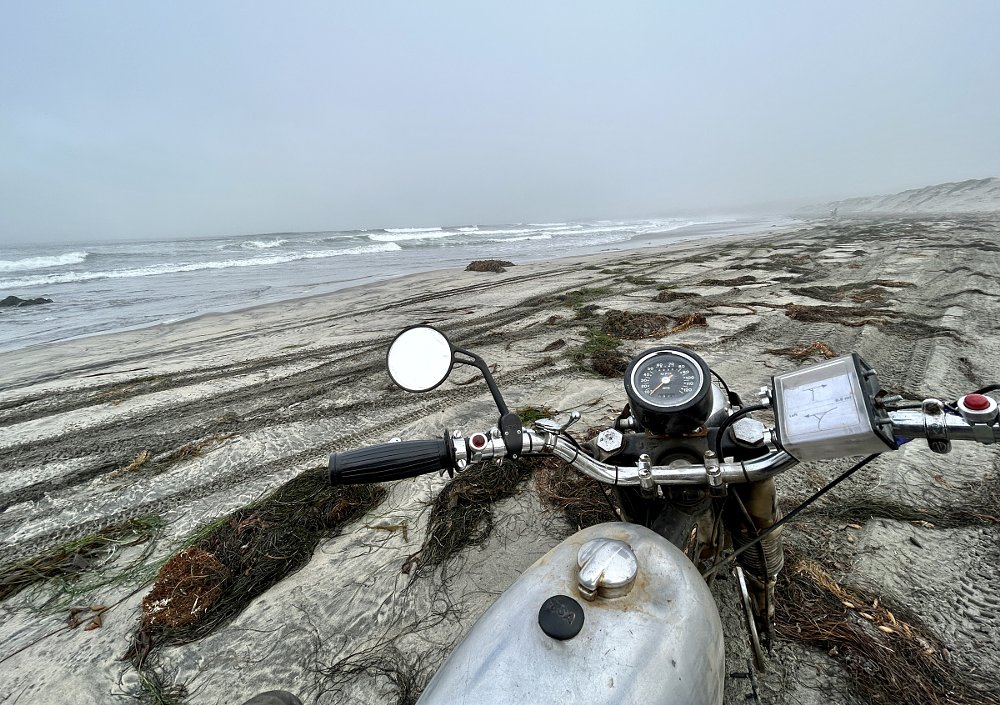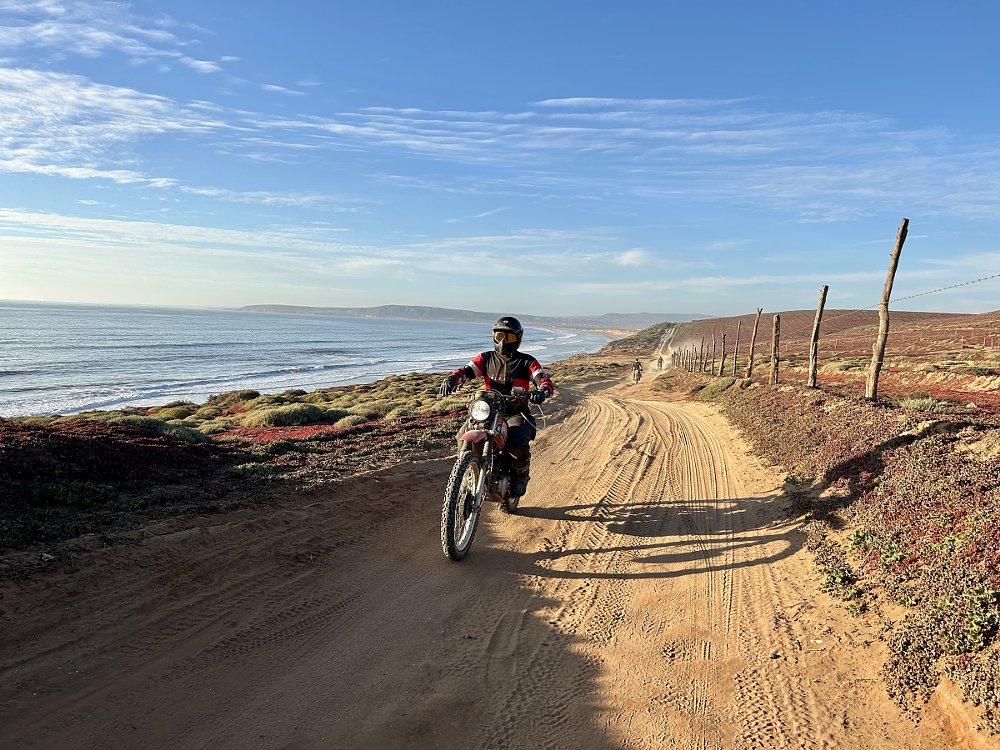It's hard to imagine a more helpless feeling than sitting astride a motorcycle without a way to easily start it on your own. And in a desolate, remote place like Baja California, the sinking fear of vulnerability is even more pronounced and raw.
There I was, on day four of the Speed Deluxe Vintage Expedition, in the middle of (dry) Lago Chapala, with support and friends out of sight, and a dead motorcycle that wouldn't start.
Over the course of five days in mid-October, a group of 23 riders with a taste for doing things the old-fashioned (i.e., hard) way, rode 600 miles around northern Baja on motorcycles that were older than 1980. Having taken part in one of Speed Deluxe's Vintage 1000 events last year, I eagerly signed up for this big adventure.
With a bit of hubris, I set my mind on building a 1969 BSA 441 Victor Special, from parts, to ride on this epic off-road adventure. Along the way, I learned the maddening intricacies of mid-century British technology, relied on a few wizened friends for help and advice, and in the process of completing this five-day route, I developed a whole new understanding of perseverance and the unexpected teamwork that is woven into the cultural fabric of motorcycle riding.

Building a BSA for Baja, missing one crucial detail
The BSA project began at my neighbor Al's house. He's an expert at restoring British bikes, especially BSAs, but he'd never dabbled in the brand's 1960s motocross machines that were ridden to glory by Jeff Smith in the sport's formative years. He had a pile of parts from a few Victors but no time to pick through them all. I'm up for a new challenge, I thought. I have some good mechanical experience; won't this be a great next step in my motorcycle education? Here's a plot twist that should come as no surprise to anyone who's tackled a basket case project: I got more than I bargained for.
But you’re here to read about Baja, not my endless hours in the garage, sourcing the right Whitworth bolt for each and every component, or pulling apart my gearbox five times in the course of a month to troubleshoot a false neutral problem. All I'll say is that Al got me into this mess, but sure enough, he got me out of it, too, with endless supplies of patience and parts.
I did not resort to my back-up plan, a faithful 1974 BMW R75/6. Instead, I arrived in San Felipe, Mexico, with my friends Jacob, Heidi, and Anthony, and an ornery little British thumper that looked pretty badass, if you'll allow me to gloat for a moment.

It was all tacos by the beach, churros by the bag, good times, and sunshine until I went to fire up the Victor for a quick check, the day before we rolled out. I kicked it a few times, fiddled with the carburetor tickler, got the decompression right, kicked it again, and all of a sudden, there was no resistance in the kickstart lever.
A terrible feeling swept over me. I'd gone through every detail on this bike, done a proper shake-out ride, made sure that dicey gearbox was perfect. I never thought twice about the kick starter. And yet, upon opening up the right side cover, it was plain to see that the ancient gear teeth had finally worn to the point where they were not reliably engaging to crank over the engine. I went to sleep that night with a horrible feeling, like I was about to dive into the middle of the Sea of Cortez with no life jacket.
Nevertheless, I started riding the next day. Adam Sheard, co-owner of Speed Deluxe and the mastermind behind these events, gave me plenty of encouragement, having seen his share of troublesome old bikes over the years. He gave me the push I needed to stay positive, and quite literally, he gave me the push I needed to bump-start the BSA.
With the motors running and wheels turning, my worries started to fade. We entered our first section of Baja sand and things got interesting. For as cantankerous as my little bike could be, it loved to run hard on the sand, floating, surfing, diving into ruts, and eagerly blipping through deep troughs.
Unfortunately, the fun was short-lived. After perhaps 15 miles of riding, my mental mechanical alarm bells went off. The engine was revving, but no power was going to the rear wheel. I feared the worst: a fatal remission of the gearbox issues I'd chased in the final crunch to prep for Baja. No, wait. The chain is moving. The rear sprocket is spinning.
All 10 of my sprocket bolts were gone.
Maybe I under-tightened the bolts. Maybe I didn't apply enough Loctite, or it was the wrong Loctite. That step of the build must have happened one cold February night last winter, so how could I remember? But there, in the remote Mojave desert, I needed some more bolts.

Thankfully, Adam was still in town and stopped at the auto parts store to get whatever they had, with his minimal Spanish. After an hour or so of us waiting in the shade of a massive cardón cactus, he arrived in his 1968 Ford F-100, a fitting rig for vintage support.
We screwed the bolts in as best we could. Since the threads were in poor condition, Jacob safety-wired them all together to supplement the red Loctite I liberally applied beforehand. It worked, but the hours spent in the sand put us way behind schedule, not to mention the dehydration. We made slow progress through sandy trails better suited for trophy trucks, eventually popping out onto Laguna Diablo, a high-speed respite from the deep desert.

By that point, however, Heidi's Honda XL250 had problems of its own and ended up on the back of Adam's truck — quite a plot twist, considering that I expected my BSA would get the rack of shame ride to camp that night. Fortunately, a little motorcycle swapping allowed everyone in my six-person group to ride on and witness a stunning sunset before descending through the starry, pitch-black night to our first campsite near San Vicente.
The rest of the trip was by no means easy, but we packed about a week's worth of mechanicals, crashes, and mishaps into the first day of riding.
Desert rides, ocean views, roadside repairs
We camped on the Pacific coast the next night, waking up to gloomy skies and pounding waves beneath pyramids of volcanic rock. We traversed the rugged desert to reach Cataviña, a forest of cardón cacti, cirio trees, and scorpions that had us nervously checking boots in the morning. By the time we returned to the beach on the Sea of Cortez, we'd found the trip's rhythm.

One thing that went a long way toward smoother days of riding was a good system to bump-start my BSA. Throughout the desert on day one, friends gave me an old-fashioned push, which was grueling in the heat and sand. I think Anthony nearly suffered heat stroke at one point. Soon, Jacob and I dabbled in the tow-strap method, with mixed results. We both had a few tip-overs that led to bent levers and embarrassment, especially in the middle of town in Lázaro Cárdenas. We learned to run the strap off our pegs for stability — and to more easily disengage once the BSA fired. Jacob and Anthony also found it effective to ride up behind me and put their boots on my frame or bags to provide a kick-start of their own.
All of that is well and good until I found myself alone on Lago Chapala, just south of the famous Coco's Corner, if you follow Baja racing.
Having forgotten my water bottle nearby, I was making a quick run back to pick it up. We'd just been racing around the dry lake bed at top speed, so maybe I was feeling a little cocky. I got disoriented by the vast dry lake bed, lost our tracks from when we rode in, and ended up too close to the shore, where things were rough. I hit a massive rut, bottomed out entirely, nearly crashed, and then without warning, the bike quit.
With the midday sun high overhead, I could barely see the outlines of riders and the support truck way off in the distance. In vain, I tried a couple solo bump starts — hopeless, I knew. I tried to wave. Could they even see me? No choice left but to start walking.
I had ample time to doubt what I was doing out there in Mexico. I successfully built this bike from parts, sure, but subjecting it to this type of riding, day after day, is an entirely different thing. Facing worst-case scenarios, I felt pretty helpless. I had ways of starting this ornery little BSA, but what if I got stranded, like I am now? Baja is remote and unforgiving, unlike anywhere else I've ridden a motorcycle, and I hadn't exactly set myself up for success.
Though it felt like hours and hours of walking, sweating, and brooding over my poor choices and lack of preparation, it probably wasn't all that long. Adam's truck appeared on the horizon, headed my way. Whether or not this was a dumb idea, I had to own it, and we had to get this bike started again. So we did.

The final day of riding was mercifully straightforward, a highway run up the east coast from Punta Final with beautiful views of the Sea of Cortez and its dramatic volcanic islands.

Our group of six rolled into San Felipe around three, which was our earliest finish of the week. Aside from my BSA's troubles, Anthony had to replace the clutch on his Honda XL 500 midway through day two, leading to another after-dark finish. Oh, and he also sorted out that 250 that Heidi was riding, discovering a loose bolt in the case that had jammed up the rotor after migrating from its home on the counter-balancer. Besides that, there were a few broken levers, some luggage failures, and plenty of sore backs and bruises along the way.

Why make it harder than it has to be?
The obvious conclusion after this week of highs and lows in Baja centers around perseverance. You find a way to make it work. That could be a creative fix to keep the old bike rolling. It could be finding the riding technique you need to make it through miles of sandy washes. It could be borrowing a welder from a kid at a taco stand to fix a slipping shift lever (not mine, but it happened).
Perseverance comes as no surprise, though. I've seen it before in the Vintage 1000. I've also experienced it riding modern dirt bikes on technical trails back home.
Beyond that, Baja showed me how motorcycle riding can be a team effort. This trip was far too involved and challenging to do alone. On a modern bike, maybe. On these pre-'80s machines? Unlikely.

Everyone who signed up for this week of riding knew what they were getting into. Amazing off-road riding, sure. Adventure in a new and remote place, definitely. But more importantly, we all knew we were getting into something that would pose unexpected challenges. We all found times to support each other because we knew the worm would turn, and at some point, we'd be the ones needing a bump-start or a welder or a roll of safety wire. To complete the route and end up back in San Felipe after five days, we needed to tap into every bit of our collective resourceful creativity to solve problems and keep rolling.
And that is just what we did.

 Membership
Membership








